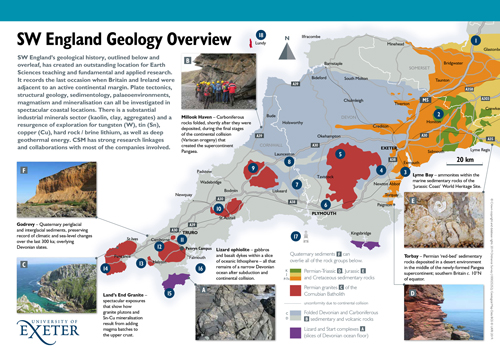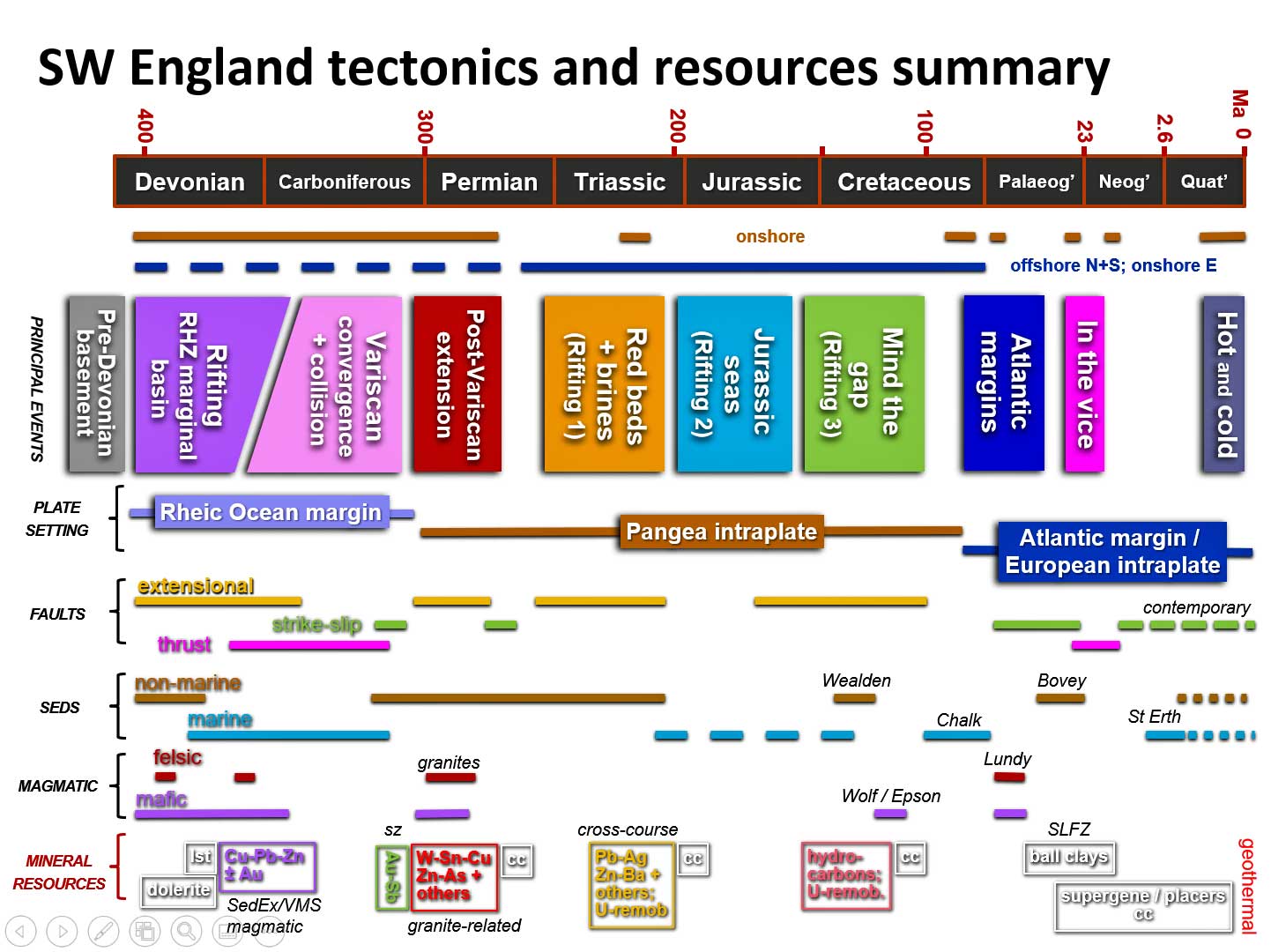Profile
Prof Robin Shail
Research overview
Geology and resources of SW England, Cornwall and the Isles of Scilly
SW England is a superb natural laboratory that, in common with other basement massifs across western and central Europe, records the development and destruction of the Variscan mountain belt during and after the formation of Pangea. My research addresses regional geological evolution and the associated fundamental processes, i.e. Variscan / post-Variscan tectonics and its influence on, and interactions between, structural geology, sedimentation, magmatism, mineralisation and landscape development (further details via right-hand sidebar).
>YouTube ExeTalks video on the geology and resources of SW England (2021)
Click image for a larger version

The geological evolution of SW England resulted in an outstanding endowment of natural resources that underpinned a globally significant mining industry for much of the 18th-20th centuries, and world-leading research on 'Hot Dry Rock' geothermal energy in the 1970s-1980s. Kaolinite has been produced from altered granites for almost three centuries and remains a major UK industrial mineral export. Since the mid-2000s there has been a resurgence of exploration interest in the UK's most prospective region for the metals tungsten (W), tin (Sn), copper (Cu), lithium (Li) and for deep geothermal energy. The first 'new' metal mine worked the strategically important Hemerdon W-Sn deposit in Devon between 2015-18 and was reposible for the UK becoming the fourth biggest global tungsten producer in 2017-18. In 2019, the deepest onshore borehole in the UK (UD-1, 5057 m TVD / 5275 MD) was completed as part of the United Downs Deep Geothermal Power Project and Eden Geothermal Limited completed their first deep geothermal well in late 2021 that is, just, the longest in the UK (4867 m TVD / 5277 MD). These are nationally and internationally significant projects.
The applied research that I undertake addresses how fundamental geological processes and regional geological evolution contribute, both positively and negatively, to these resources and their exploration and production (figure below). I've been involved in collaborative research and knowledge transfer with most of the resource companies who have operated in SW England and have received NERC-funding for both geothermal- and minerals-related research.
Click image for a larger version

Current and recent funded research projects
Since 2009 I have generated PI income of £1.15M and my Co-I share of income is £0.14M.
- 2022- NERC, National Environmental Isotope Facility, grant-in-kind for collaborative study with Dr Simon Tapster - A deeper insight into batholith construction and its influence on geothermal heat production - a 4D view from the UD-1 borehole in Cornwall (supporting NERC iCASE PhD of Chris Dalby)
- 2020-2023 European Regional Development Fund. Deep Digital Cornwall (Co-I).
- 2020-2022 European Regional Development Fund (Priority Axis 4: Supporting the Shift Towards a Low Carbon Economy in All Sectors). Eden Geothermal (Co-I).
- 2019-22 NERC fourth round highlight topic: Deep subsurface heat as a potential major future energy resource - Geothermal Power Generated from UK Granites (GWatt) (NE/S003886/1, Exeter PI)
- 2018-22 NERC Industrial CASE PhD studentship with GeoScience Limited (industrial supervisor Dr Tony Batchelor) - Geological controls on upper crustal heat flow for deep geothermal energy in Cornwall (NE/R008612/1, Lead Supervisor)
- 2017-18 Satellite Applications Catapult Limited contract research - Space enabled exploration and monitoring of Cornwall lithium resources (PI).
- 2016- NERC Isotope Geosciences Facilities Steering Committee, grant-in-kind for collaborative study with Dr Simon Tapster (NIGL) - Long‐lived structural controls on magma genesis, crustal pathways and fluid traps in the post-orogenic SW England batholith: the key to forming the world‐class Hemerdon tungsten‐tin deposit?
- 2015-16 NERC Innovation Project - Tellus How - An exemplar approach for end-user innovation and follow up of major NERC environmental survey projects (NE/M021777/1, Co-I).
- 2014-18 NERC GW4+ DTP PhD - Advanced Geoscience Modelling of South West England using TELLUS high resolution multivariate data (joint with, and hosted by, the British Geological Survey).
- 2012-14 NERC/TSB Knowledge Transfer Partnership (No. 8750) with Imerys Minerals Ltd - Characterisation of the occurrence of critical metals (Nb/Ta/REE/W) + Sn within china clay operations and evaluation of processing strategies and the viability of extraction as a by-product (PI).
- 2010-12 EU FP7-ENV-2009-1 (Led by Geonardo Ltd., Hungary) - Impact Monitoring of Mineral Resources Exploitation (Co-I).
Collaboration and Knowledge Transfer
The knowledge and understanding associated with a long period of geological research in the region is underpinned by, and further contributes to, collaborative and contract minerals industry research / consultancy and knowledge transfer. Present and past collaborators include: British Geological Survey, Cornish Lithium, Cornish Tin, Cornwall Council, Cornwall Resources, CSM Associates, David Roche Geo Consulting, Eden Geothermal, EGS Energy, Elcon Western, GeoScience, Geothermal Engineering, Helford Geoscience, Imerys Minerals, JSC Altynamas, Menteri Besar Incorporated, Satellite Applications Catapult, Treliver Minerals, Tungsten West, Western United Mines and Wolf Minerals on projects that typically involve regional geology, structural geology, granites, mineralisation and/or mineralogical characterisation and their mineral / geothermal resource implications. The National Trust and The University of Plymouth have been collaborators on coastal landsliding projects.
